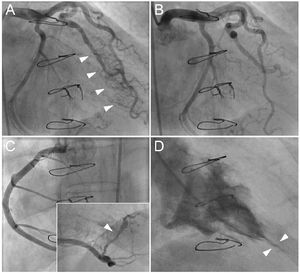Figure 1.
A 61-year-old Caucasian female presented with exertional chest pain for 3 months, radiating into neck and shoulders. Twenty years ago, she had undergone surgical closure of an atrial septal defect and had been asymptomatic since then. The patient was obese but had no classical risk factor of cardiovascular disease. On physical examination, blood pressure was 134/78 mm Hg with a regular pulse of 95/min, normal heart sounds and a slight systolic murmur.
The electrocardiogram at rest showed sinus rhythm with inverted T-waves in leads I, II, aVL and V2 through V6. Laboratory tests were normal. We performed a single-photon emission computed tomography with dipyridamol during which the patient experienced severe angina while myocardial perfusion imaging revealed no significant abnormality. Considering the known limitations of this technique in obese patients, we then performed coronary angiography. We found no stenosis but both, multiple microfistulae between left anterior descending coronary artery and left ventricle (microfistulae were seen in diastole [A] but not during systole [B]) as well as a large macrofistula between right coronary artery and left ventricle (C, insert). Left ventricular angiography demonstrated the typical pattern of apical hypertrophic cardiomyopathy: a spade-like configuration of the left ventricle (D). The presence of apical hypertrophy was confirmed by transthoracic echocardiography which showed no further abnormality. The patient remained asymptomatic under high-dose a beta-blocker therapy (metoprolol 200 mg/d).
Thus, in this patient the combination of three potential causes of angina pectoris, which are each very rare, was successfully treated by a single and very common drug.


